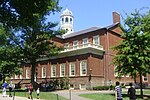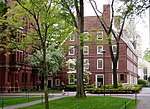Statue of John Harvard

John Harvard is a sculpture in bronze by Daniel Chester French in Harvard Yard, Cambridge, Massachusetts honoring clergyman John Harvard (1607–1638), whose deathbed bequest to the "schoale or Colledge" recently undertaken by the Massachusetts Bay Colony was so gratefully received that it was consequently ordered "that the Colledge agreed upon formerly to bee built at Cambridg shalbee called Harvard Colledge." There being nothing to indicate what John Harvard had looked like, French used a Harvard student collaterally descended from an early Harvard president as inspiration. The statue's inscription—JOHN HARVARD • FOUNDER • 1638—is the subject of an arch polemic, traditionally recited for visitors, questioning whether John Harvard justly merits the honorific founder. According to a Harvard official, the founding of the college was not the act of one but the work of many, and John Harvard is therefore considered not the founder, but rather a founder, of the school, though the timeliness and generosity of his contribution have made him the most honored of these. Tourists often rub the toe of John Harvard's left shoe for luck.
Excerpt from the Wikipedia article Statue of John Harvard (License: CC BY-SA 3.0, Authors, Images).Statue of John Harvard
Massachusetts Avenue, Cambridge
Geographical coordinates (GPS) Address Nearby Places Show on map
Geographical coordinates (GPS)
| Latitude | Longitude |
|---|---|
| N 42.37447 ° | E -71.11719 ° |
Address
Harvard University
Massachusetts Avenue
02138 Cambridge
Massachusetts, United States
Open on Google Maps







